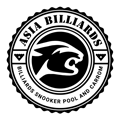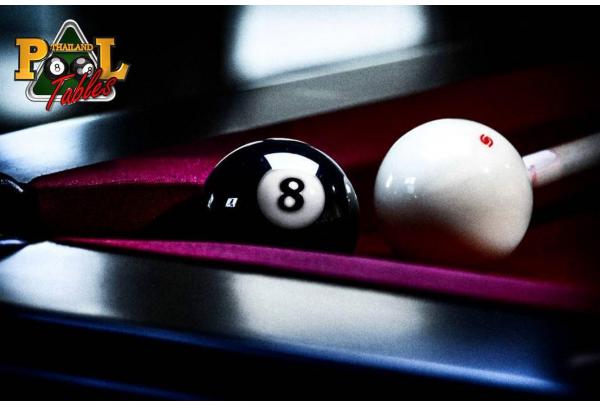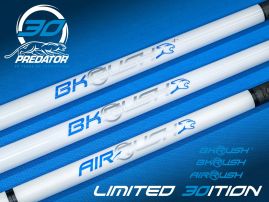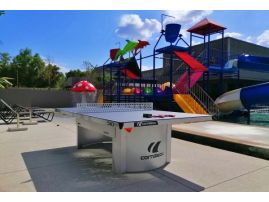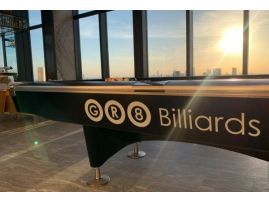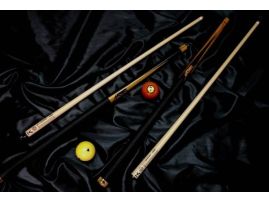A. BALLS AND RACKING
1. The game is played with one cue ball and 15 numbered object balls.
2. The balls are racked in a triangle at the foot of the table with the 8-ball in the center of the triangle, the first ball of the rack on the footspot, a stripe ball in one corner of the rack and a solid ball in the other corner, as the above illustration shows.
3. The object of the game is to make one group of numbered object balls, either stripes or solids, and then LEGALLY POCKET THE 8-BALL which then wins the game.
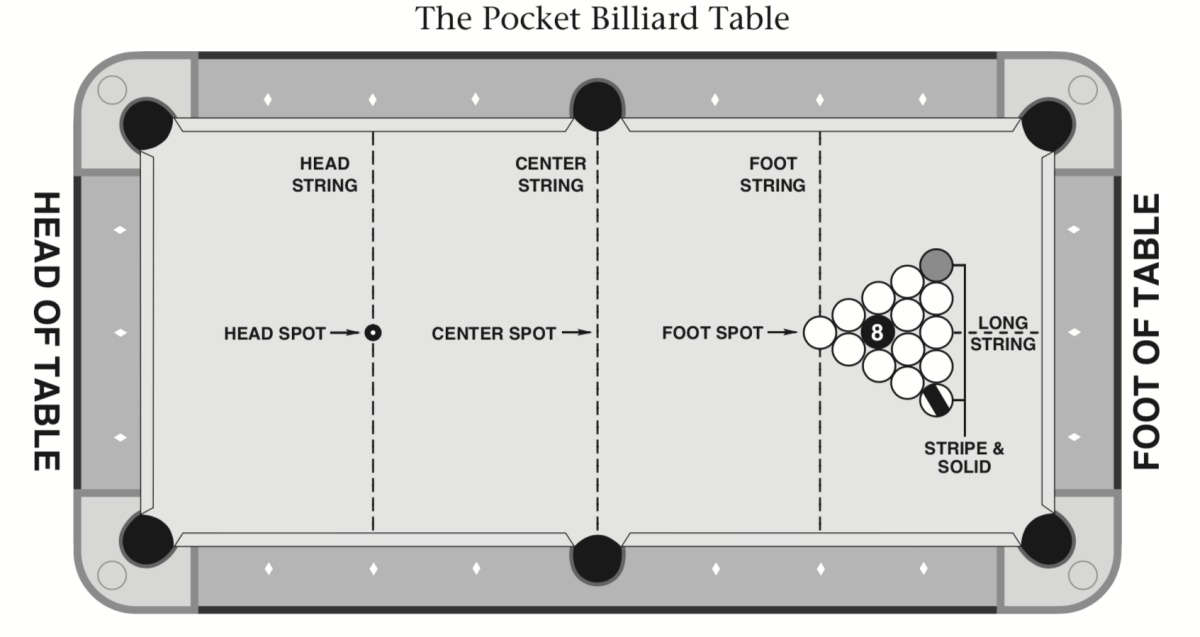
B. BREAK SHOT
1. Start of play - the home team breaks first and writes their line-up down first. The break will alternate thereafter. During International competition, the teams will flip a coin to determine home team.
2. If the breaker hits the racked balls with the cue ball driving four or more numbered balls to a cushion or pocketing one or more object balls, the game is considered started. If the player fails to make a legal break, it is not a foul; however, the opponent has the option (1) accepting the table in posi- tion and shooting, or (2) have the balls reracked and shooting the break himself or have original breaker rebreak.
3. Stopping or deflecting the cue ball prior to hitting the racked balls are con- sidered fouls and loss of turn. The opponent will receive cue ball in hand behind the headstring.
4. When positioning the cue ball for the break shot, the base of the ball must be behind the headstring (kitchen).
5. If a player scratches on a legal break shot,
(1) all balls pocketed remain pocketed (exception, the 8-ball),
(2) it is a foul,
(3) the table is open.
PLEASE NOTE: Incoming player has cue ball in hand behind the headstring and may not shoot an object ball whose base is not outside the headstring, unless he/she first shoots the cue ball past the headstring and causes the cue ball to come back behind the headstring and hit the object ball. If a player positions the cue ball completely and obviously outside the kitchen and shoots the cue ball, it is a foul, if called by the opponent.
6. The opposing player must inform the breaking player of improper position ing of the cue ball before the shot is made. If the opposing player does not so inform the breaking player before the shot is made, the break is consid- ered legal. If the shooting player is informed of improper positioning, he/she must then reposition the cue ball.
7. Making The 8-Ball On The Break: (Leagues may adopt Option #1 or Option #2)
- Option #1. An automatic win for the player breaking, however, if the cue ball is scratched when making the 8-ball on the break, the opponent wins the game.
- Option #2. The breaker may ask for a rerack or have the 8-ball spotted and continue shooting. Should the breaker pocket the 8-ball and scratch, the incoming player has the option of spotting the 8-ball and shooting from behind the headstring or reracking and assuming the break. Using Option #2, a game cannot be won or lost with an 8-ball on the break, regardless of what is pocketed on the same shot.
8. If the player legally breaks the racked balls and does not make any balls, his opponent then shoots, having an open table.
9. If a player jumps an object ball off the table on the break shot, it is a foul and the incoming player has the option of
(1) accepting the table in position and shooting, or
(2) taking cue ball in hand behind the headstring and shooting. Any jumped balls are spotted in numerical order.
C. OPEN TABLE
The table is “open” when the choice of groups (stripes or solids) has not yet been determined. When the table is open, it is legal to hit a solid first to make a stripe or vice versa. Note: The table is always open immediately after the break shot. When the table is open it is legal to hit any solid or stripe or the 8-ball first in the process of pocketing the called stripe or solid. On an open table, all pocketed balls remain pocketed. The choice of stripes or solids is not determined on the break even if balls are made from only one or both groups.
THE TABLE IS ALWAYS OPEN IMMEDIATELY AFTER THE BREAK SHOT. The choice of group is determined only when a player legally pockets a called object ball after the break shot.
D. GAME
In Call Pocket, obvious balls and pockets do not have to be indicated. It is the oppo- nent’s right to ask which ball and pocket if he is unsure of the shot. Banks and com- binations are not considered obvious and both the object ball and the pocket must be called or it is a loss of turn. When calling the shot, it is NEVER necessary to indicate details such as the number of cushions, banks, kisses, caroms, etc. Any balls pocketed on a foul remain pocketed, regardless of whether they belong to the shooter or the opponent.
The opening break is not a "called pocket" Any player performing a break shot in 8- Ball may continue to shoot his next shot so long as he has legally pocketed any object ball on the break.
When a player has pocketed all of the balls in his group, he then shoots at the 8-ball, physically designating his pocket with a pocket marker. The marker is to be placed on the table completely within the first two diamonds on either side of the pocket. The entire area between the diamonds included. You do not have to touch or move the marker if it is already at your intended pocket.
E. PLAY
1. If a shooter inadvertently pockets his opponents ball, it remains down, however, if the shooter does not legally pocket one of his own group, he loses his turn.
2. Each player continues to shoot so long as he legally pockets any of his object balls (Exception: calling a safety). Should a player fail to pocket his designated group ball, he shall lose his turn.
3. If a player fails to hit the 8-ball while shooting at it, it is a foul and the game continues. When the 8-ball is the legal object ball, a scratch or foul is not a loss of game if the 8-ball is not pocketed or jumped off the table. Incoming player has cue ball in hand.
4. In the event the cue ball or an object ball stops on the edge of the pocket then falls into the pocket because of vibrations, fan or stamping of feet, it shall be replaced on the edge of the pocket as near as possible to its position before interference.
5. If any object ball is jumped off the table, it is a foul and loss of turn, unless it is the 8-ball, which is a loss of game. Any jumped object balls are spotted in numerical order.
6. SLOW PLAY RULE: Exaggerated slow play will be penalized. After a warn ing, any longer than ONE MINUTE between shots will be a foul. The third infraction will result in loss of game. During National competition, referees judgment will prevail and both players will be timed.
7. STALEMATED GAME: If in 3 consecutive turns at the table by each player (6 turns total), they purposely foul or scratch and both players agree that attempting to pocket or move an object ball will result in immediate loss of game, then the game will be considered a stalemate. The balls will then be re-racked and the breaker of the stalemated game will break again.
PLEASE NOTE: Three consecutive fouls by one player is not a loss of game.
F. LOSS OF GAME
- Pocketing the 8-ball when it is not the legal object ball except on an opening break.
- Pocketing the 8-ball on the same stroke as the last of his group of balls.
- Jumping or knocking the 8-ball off the table at any time.
- Pocketing the 8-ball in a pocket other than the one designated.
- Fouling while (pocketing) the 8-ball in the designated pocket.
- Third infraction of the slow play rule.
- Pocketing the 8-ball and the cue ball on the break stroke. (This varies, if your league considers an 8-ball break a win.)
- Not correctly marking the pocket while pocketing the 8-ball.
Note: All infractions above must be called before the next shot is taken.
Only the players involved may call an infraction.
G. LEGAL SHOTS
On all shots (exception: page 11C and on the break), the shooter must hit one of his group of balls first and (1) pocket any group ball, or (2) cause the cue ball or any other ball to contact a rail.
* (There are two groups of balls: stripes and solids)
PLEASE NOTE: It is permissible for the shooter to bank the cue ball off a rail before contacting his object ball; however, after contact with his object ball, any group ball must be pocketed, OR the cue ball or any other ball must contact a rail.
"SAFETY" SHOT: For tactical reasons a player may choose to pocket an obvious object ball and also discontinue his turn at the table by declaring "safety" in advance. A safety shot is defined as a legal shot. If the shooting player intends to play safe by pocketing an obvious object ball, then prior to the shot, he must declare a "safety" to his opponent. If this is NOT done, and one of the shooter’s object balls is pocketed, the shooter will be required to shoot again. Any ball pocketed on a safety shot remains pocketed.
H. FOULING
All fouls must be called and acknowledged before next shot is taken. (exception: scratching)
The following results in fouls:
- Failure to make a legal shot as noted above.
- Shooting the cue ball into a pocket or off table.
- It is a foul when a player scratches on the break, or deflects the cue ball prior to hitting the racked balls. The incoming player receives (Cue ball in hand behind the headstring).
- When placing the cue ball in position, any forward stroke motion contact- ing the cue ball will be a foul, if not a legal shot.
- Shooting without at least one foot touching the floor.
- Coaching is a foul. Any member of a team called for coaching will result in a foul on the team member shooting.
- Object Ball Frozen To Cushion Or Cue Ball.
This applies to any shot where the cue ball’s first contact with a ball is with one that is frozen to a cushion or to the cue ball itself. After the cue ball makes contact with the frozen ball, the shot must result in either:
a) A ball being pocketed, or;
b) The cue ball contacting a cushion, or;
c) The frozen ball being caused to contact a cushion attached to a separate rail, or;
d) Another object ball being caused to contact a cushion with which it was not already in contact.
Failure to satisfy one of those four requirements is a foul.
A ball which is touching a cushion at the start of a shot and then is forced into a cushion attached to the same rail is not considered to have been driven to that cushion unless it leaves the cushion, contacts another ball, and then contacts the cushion again. An object ball is not considered frozen to a cushion unless it is examined and announced as such by either the referee or one of the players prior to that object ball being involved in a shot.
- ACCIDENTALLY moving or touching any ball is not a foul unless:
1) the moved ball is the cue ball or
2) a moved ball makes contact with the cue ball or
3) a moved ball that is jumped off the table or pocketed or causes any ball to be jumped off the table or pocketed. (exception to #3: If the 8-ball is jumped off the table or pocketed it is loss of game if called by the opponent before the next shot is taken). Only opponent may replace the ball moved as closely as possible or leave it where it rests. If the shooter replaces the moved ball, it will be considered a foul. - Picking up or shooting the cue ball while any balls are still in motion is a foul.
- Push shots and or double hits will be considered fouls.
- With cue ball in hand, touching any object ball with the cue ball is a foul or touching any object ball with your hand while touching the cue ball is a foul.
- When the slow play rule is enforced taking longer than ONE MINUTE between shots is a foul.
- Jumping object balls off the table.
- After a scratch on a legal break, if a player positions the cue ball completely and obviously outside the kitchen and shoots it is a foul.
- If your opponent commits a foul and you do not receive his/her acknowl- edgement of such foul prior to touching the cue ball you have committed a foul. (exception: scratching)
- Illegal jumping of ball.
H. FOULING
- Only the players involved may call a foul. In the event of a foul call, the opposing player receives cue ball in hand anywhere on the table. This means that the player can place the cue ball anywhere on the table (the cue ball does not have to be behind the headstring except on opening break or immediately after a foul on the break).
- A player must stop shooting when a foul is called. If a player refuses to yield to a foul call, the opposing captain may protest.

